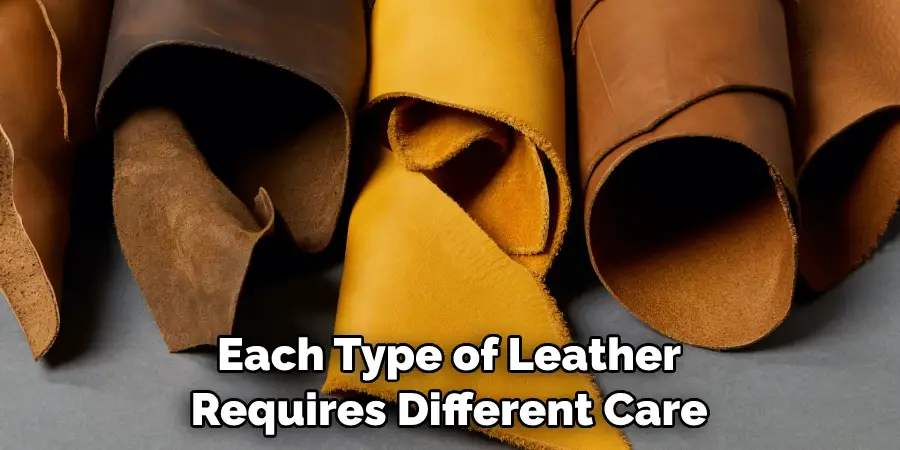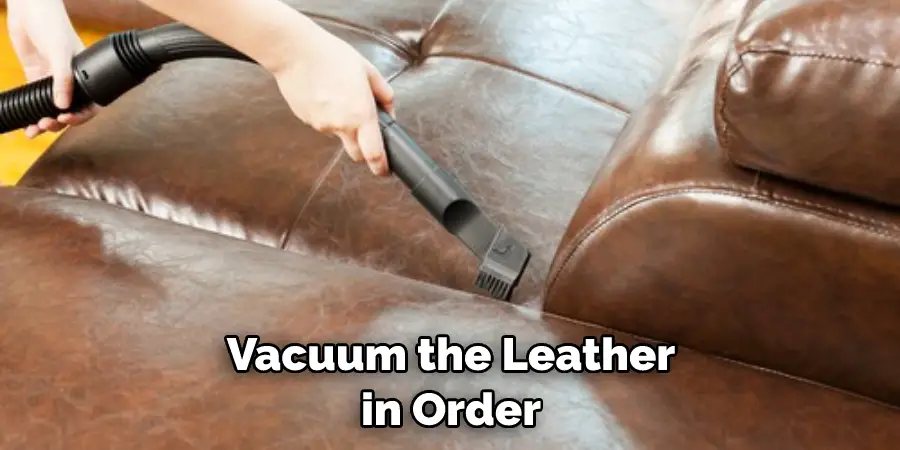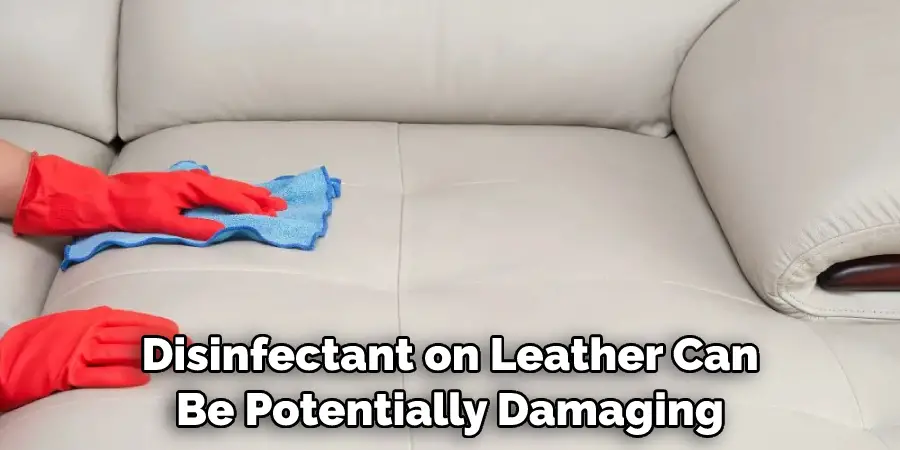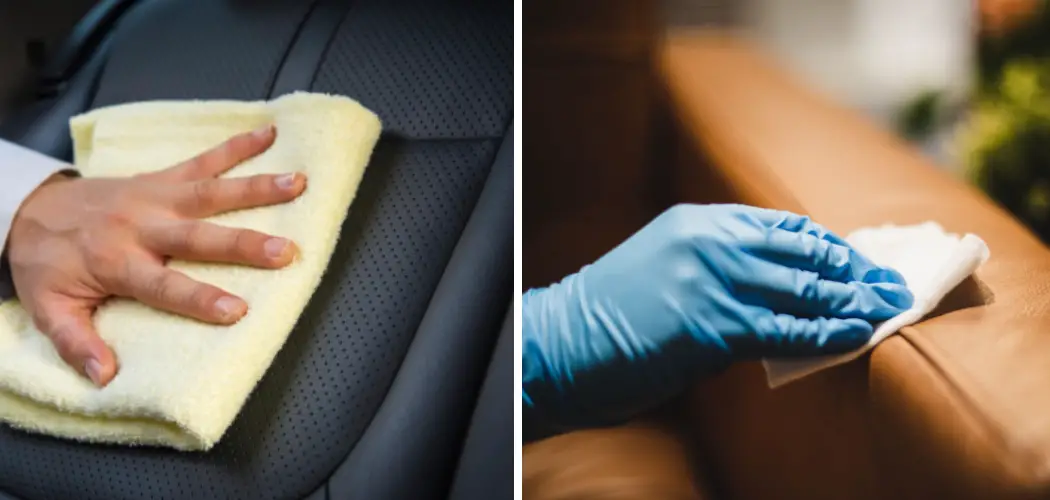Leather is a natural material that can become contaminated with bacteria, mold, and mildew over time. Without proper care, these contaminants can damage the leather’s appearance and shorten its lifespan. Disinfecting your leather items is important in maintaining their quality and longevity. Regularly disinfecting your leather goods will help protect them from dirt, dust, oils, and other contaminants that can build up on the surface.

One of the main advantages of using leather for furniture and clothing is its durability. Leather is able to withstand everyday wear and tear. It also has a natural resistance to some bacteria and fungi, making it perfect for use in areas where hygiene is important.
In addition, leather requires minimal maintenance compared to other materials, such as fabric, which can be prone to stains and other dirt buildup. You can find step-by-step instructions on how do you disinfect leather in this blog article.
What Type of Leather Should Be Disinfected and Why?
Leather items that come into contact with the skin should be disinfected regularly to reduce the risk of infection. Bags, wallets, and clothing are some examples of items made out of leather that should be treated properly when it comes to hygiene and sanitation.
Leather is a porous material that can easily absorb liquids, meaning that if any germs or bacteria are present, they can easily enter the material and be difficult to remove. Regular disinfection is a necessary part of good hygiene practices for leather items.
To effectively disinfect leather, it is important first to identify what type of leather you are dealing with. Leather can come in full-grain, top-grain, split (or corrected-grain), and bonded leather. Each type of leather requires different care and disinfection methods, so it is important to determine what type you are handling before beginning the disinfecting process.

Step-by-step Instructions for How Do You Disinfect Leather
Step 1: Inspect the Leather Surface
Before beginning to disinfect any leather, it is important to inspect the surface of the material thoroughly. Look for signs of dirt, mildew, and other types of contaminants that may have built up on the surface since its last cleaning. If necessary, use a soft brush or vacuum with a brush attachment to remove excess dust and debris before using any cleaning products.
Step 2: Sanitize with Mild Soap and Water
Make a solution of mild soap and warm water. Dip a soft cloth in the solution, then wring out any excess liquid before gently wiping down the leather surface. Take care to avoid soaking the material too much during this process, as it could cause it to become waterlogged.
Step 3: Rinse the Leather with Clean Water
After wiping down the leather with a soapy cloth, use a clean damp cloth to rinse away any remaining soap and dirt from the surface. Again, take care to avoid saturating the material with too much liquid.

Make a solution of rubbing alcohol and water, or vinegar and water. Dip a clean cloth in the mixture, then wring out any excess liquid before wiping down the leather surface. Be sure to take care when using either cleaning product on leather, as they can be too harsh for some types of material.
Step 4: Apply a Leather Conditioner
After disinfecting the leather, use a leather conditioner to help restore and protect its finish. Work the product into the surface using a soft cloth or applicator sponge in circular motions.
Allow the conditioner to dry before wiping off any excess with a clean cloth. Once you have finished cleaning and conditioning the leather, allow it to air dry completely before using it again. This will help ensure that no contaminants are left behind on the material’s surface.
Step 5: Clean up Any Spills Immediately
To prevent any staining or discoloration on the leather surface, clean up any spills as soon as they occur. Use a soft cloth dampened with mild soap and water to wipe away the excess liquid before it has a chance to penetrate the material. To keep leather products in good condition, be sure to store them away from direct sunlight. Posing the material to strong ultraviolet can cause it to fade or crack over time.
Step 6: Avoid Using Harsh Detergents
When cleaning leather, avoid using too harsh detergents for the material as they could cause it to become brittle or begin to peel. To help keep leather products looking their best, be sure to reapply a leather conditioner periodically – at least once every six months. This will keep the material supple and protected from wear and tear over time.
Following these easy steps will help ensure that your leather products stay clean and well-maintained.
Tips for How Do You Disinfect Leather
- Always consult the cleaning instructions on the leather before attempting to clean or disinfect it. Different types of leather require different procedures, so it is important that you follow the given instructions closely.
- Wear protective gloves while handling chemicals and cleaners when disinfecting leather. This will protect your hands from any potential damage from harsh chemicals.
- Thoroughly vacuum the leather in order to remove any dust and dirt particles that can reduce the effectiveness of disinfecting products.
- Use a mild soap solution or mild detergent to spot clean any stains on the leather before attempting more serious cleaning methods. Make sure to rinse off the soap solution with clean water thoroughly.
- Make sure to use a leather disinfectant specifically designed for leather furniture or clothing. Do not use any harsh chemical cleaners, as this could potentially damage the leather.
- Follow the directions on the packaging of the disinfectant closely in order to ensure that it is used correctly and safely.
- Test out the cleaning products and disinfectants on a small patch of leather before using them on the entire piece of furniture or clothing item. This will help ensure that it is safe to use and won’t cause any damage to the leather.

Following these tips can help keep your leather items in great condition while protecting your health and safety. Disinfecting leather can help keep it clean and free from germs and bacteria.
What Kind of Cleaning Products Can You Use to Disinfect Your Leather Safely?
When looking for cleaning products to disinfect leather, it is important to be sure that the product you choose will not damage the material. Avoid harsh chemicals such as bleach or any other abrasive cleaners when tackling dirt and grime on your leather goods.
Instead, look for a solution specifically made for leather that does not contain these harmful ingredients. Many leather cleaners are designed to gently lift dirt and stains from the material without damaging it.
Before using any cleaner, be sure to test a small area of the item first. This will ensure that the cleaning product does not cause any discoloration or weakening of the leather’s fibers. If you notice any changes in color or texture after testing the product, discontinue use immediately.
Are There Any Special Techniques or Tips That May Help Me Do This Properly?
Yes, a few special techniques and tips may help you disinfect your leather items properly. Firstly, it is important to clean the surface of the leather before attempting any actual disinfecting. Simply use a soft, lint-free cloth and some warm water mixed with a mild cleaner such as soap or detergent to do this.
Gently rub the mixture into the leather, then use another soft cloth to wipe off any excess. Once the surface of the leather is clean, you can begin disinfecting it. This can be done with either a commercial product or by making your own solution at home using equal parts of distilled white vinegar and water.
When using a commercial product, be sure to follow all instructions carefully. When making your own solution, pour the mixture into a spray bottle and then lightly apply it to the leather. Allow this to dry naturally before wiping away any excess with a clean cloth.
Lastly, after you have finished disinfecting the surface of your leather item, be sure to condition it. This will help keep the leather soft and free from cracking or splitting. A quality leather conditioner should be applied in small amounts, then allowed to soak into the leather before wiping away any excess with a clean cloth.
Is There a Risk of Damaging the Leather if You Use the Wrong Cleaning Product?
Using the wrong cleaning product or disinfectant on leather can be potentially damaging to the material. It is important to use an appropriate cleaner for your specific type of leather and always read instructions carefully before applying a cleaning product.

Furthermore, never use any harsh chemicals such as bleach or rubbing alcohol on leather, as these can cause discoloration and deterioration of the material. Additionally, it is important to note that some leathers may be particularly sensitive and could require a milder cleaning approach. If in doubt, seek advice from professionals and manufacturers before attempting to clean or disinfect your leather item.
In general, it is best practice to avoid harsh chemicals when cleaning or disinfecting any material, and leather is no exception. It is always beneficial to use naturally-derived cleaning products or natural oils, such as those derived from tea tree oil, to ensure the safety of your leather item.
Furthermore, be careful not to over-clean your leather as this can cause drying out of the material and potentially weaken it in the long term.
Conclusion
In conclusion, it is to know the proper techniques for disinfecting leather. Proper cleaning and maintenance can help preserve leather items, preventing the spread of bacteria and other germs. To clean leather, use a soft cloth or brush with soapy water and mild detergent, followed by a dry cloth.
Consider using a leather cleaner for deep cleaning or when dealing with stubborn stains. To disinfect leather, use an alcohol-based solution or disinfectant and wipe down the surface with it. Avoid harsh cleaners as they may damage leather. I hope reading this post has helped you learn how do you disinfect leather. Make sure the safety precautions are carried out in the order listed.

